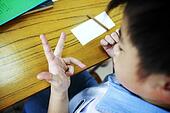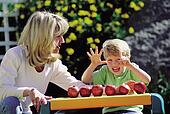Mathematics is one of my weakest subjects since my secondary school days. Mathematics only reminds me of my poor grades in school as it would be the only subject which will be underlined with a red ink in my progress book. I can clearly remember how my teacher reads out test results in descending order causing me embarrassment and made feel even more demoralized. My parents sent me for countless tuition to improve my grades however it just didn’t help much. I guess the interest in the subject plays a huge role to the contribution of grades.

Solving Math problems, memorizing formulas and working out sums from different angles always seem tedious to me. It was never a subject I enjoyed learning at all. I never saw it in a positive way compared to language.
When I noticed that one part of my course syllabus is on Mathematics, I started to ponder on what it has got to do with Literacy?
Then again, it is a known fact that mathematics is found in our daily lives. Mathematics is important as it is evident in the number of times of our heart beats to the amount of flour and sugar needed to be used to bake a cake. Mathematics is everywhere. So no matter how much I’ve no interest for the subject; I still have to impart the basic skills and knowledge to my pre-schoolers at school. This is to make sure that they do not grow to become like me someday. However, at times I do find it difficult to plan lessons or even think of creative ideas, strategies and activities for the math learning corner compared to other learning areas.
When I began reading the first chapter it really gave me a better insight and motivation to teaching mathematics. Before reading this book, I was not aware that there were the NCTM standards as I’ve never heard about it before. I’ve always followed the publication ‘Nurturing Early Learners’ by the ‘Ministry of Education’ for references and as a guide to fulfil the learning goals listed by them.

However, even if the principles for both differ, some of the objectives are almost the same. For an example, the learning principle in NCTM says ‘Students must learn mathematics with understanding, actively building new knowledge from experience and prior knowledge’ and Nurturing Early Learners believe that ‘Effective learning of new meaning in mathematics builds on children’s knowledge and guides them to see connections between what they already know and the new relationships about numbers’. Both are giving us the message that children learn new mathematics skills by enhancing or expanding their prior knowledge of an old skill.
And to generate these strategies children have to know what they have learnt and need to know what they are learning as well as to know what they are doing and how to go about doing it. In Chapter 2, it is written that Mathematics is made up of pattern and order. This is very true as young children are able to see patterns and orders better than just digits and formulas. To allow them to understand the different topics, the teacher has to facilitate how a problem can be seen in many other ways to be solved. This would allow children of different development range to connect their understanding of a problem.
By reading these two chapters, my interest of reading the book is greater. And now I feel that although it is a little too late for me to improve on my mathematic skills by changing my views now. It is never too late for me to learn more from this module to change my views positively about mathematics to benefit the many other children in my class.
No comments:
Post a Comment